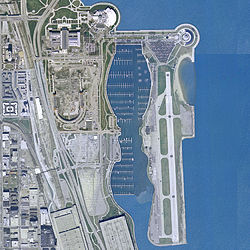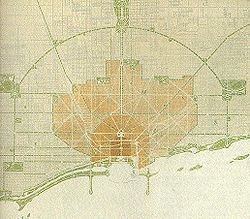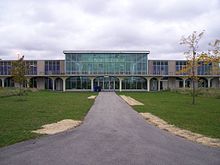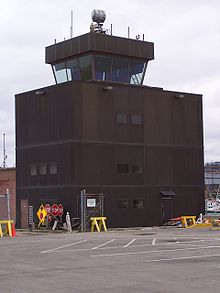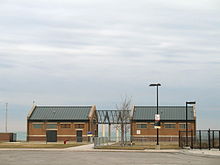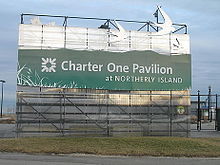- Meigs Field
-
Merrill C. Meigs Field Airport (IATA: CGX, ICAO: KCGX), was a single strip airport that operated from December 1948 until March 2003. It was built on Northerly Island, the man-made peninsula that was also the site of the 1933–1934 Century of Progress in Chicago.
The airport opened on December 10, 1948, and became the country's busiest single-strip airport by 1955. The latest air traffic tower was built in 1952 and the terminal was dedicated in 1961. The airfield was named for Merrill C. Meigs, publisher of the Chicago Herald and Examiner and an aviation booster.
Northerly Island, owned by the Chicago Park District, is the only lakefront structure to be built based on Daniel Burnham's 1909 Plan of Chicago. The island was to be populated by trees and grass for the public enjoyment by all. However, drafted less than six years after the Wright brothers' historic flight, the 1909 plan did not envision any airports for Chicago.
The airport was a familiar sight on the downtown lakefront. It was also well-known as the default takeoff field in many early versions of the popular Microsoft Flight Simulator software program. It is an airport that is featured in Microsoft's Midtown Madness computer game (1999) and Reflections' Driver 2 video game, which are based in Chicago.[1] The airport area is also the central location of the short documentary film Powers of Ten by Charles and Ray Eames.
The Main Terminal Building was operated by the Chicago Department of Aviation and contained waiting areas as well as office and counter space. The runway at Meigs Field was nearly 3,900 by 150 ft (1,200 by 46 m). In addition, there were four public helicopter pads at the south end of the runway, near McCormick Place. The north end of the runway was near the Adler Planetarium.
Contents
History
Construction
While the 1909 Plan of Chicago had no provision for air service, technological breakthroughs would quickly render the Plan at least partially obsolete.[citation needed] Chicago's first airplane flight took place in 1910 in Grant Park, adjacent to Northerly Island, with an international aeronautical exhibition at the same location in 1911. Then, in 1918, regular air mail service to Grant Park began. However, Grant Park was unsuitable for the city's growing aviation needs.
By 1916, Edward H. Bennett, co-author of the Plan of Chicago, wrote that a lakefront location would be most suitable for an airport serving the central business district. Daniel Burnham died in 1912. In 1920, Chicagoans approved a bond referendum to pay for landfill construction of the peninsula, and in 1922 construction began.[2] That same year Mayor William Hale Thompson recommended locating the downtown airport there. A few years later the Chicago South Park Commission voted in agreement. In 1928, the Chicago Association of Commerce, representing the business community, also advocated for the lakefront airport.[2]
The Great Depression put numerous civic plans on hold, including the airport. Construction continued on the peninsula itself, with the 1933 World's Fair occupying the just-completed peninsula. In the 1930s the Chicago City Council and Illinois State Legislature passed resolutions to create the airport, but both the poor economy and World War II intervened.[2]
Operation
Almost immediately after World War II, in 1946, airport construction began. That same year the Illinois state legislature deeded 24 acres (9.7 ha) of adjacent lake bottom to Chicago for additional landfill, to make the property large enough for a suitable runway. Aviation technology had advanced rapidly during World War II. The airport opened on December 10, 1948, in a grand ceremony.[2]
On June 30, 1950, the airport was officially renamed "Merrill C. Meigs Field".[2] Various improvements took place over the years, including the 1952 opening of an air traffic control tower, the 1961 opening of a new terminal building (dedicated by Richard J. Daley), runway lengthening, and the late 1990s charting of two FAA instrument approaches allowing landings in poor weather conditions. By the 1970s Meigs Field became a critical facility for aeromedical transport of patients and transplant organs to downtown hospitals as medical transportation technology modernized.
Meigs Field also provided commuter airline service to the public, peaking in the late 1980s as Mayor Richard M. Daley took office. During the 1960s to 1980s, typical destinations were Springfield and Carbondale, and typical aircraft were the Beechcraft Model 99 and Piper PA-31 Navajo. In the late 1970s Air Illinois operated the 44-passenger turboprop Hawker Siddeley HS 748 at Meigs, the largest aircraft to use it on a regular basis.
Numerous VIPs used the airport to maintain security and to avoid inconveniencing the Chicago traveling public, including President John F. Kennedy. In a common pattern, Air Force One would land at a larger area airport, and the President would take a helicopter to Meigs Field to avoid the complications of a Secret Service escort via Chicago's expressways.[citation needed]
On October 15, 1992 a Boeing 727 that was donated from United Airlines to the Chicago Museum of Science and Industry made its final landing at Meigs, on its way to be transported to the museum to become an exhibit. This was notable because Meigs' runway was somewhat shorter than others that this type of aircraft normally uses. Still, the lightly loaded jet did not require all of the runway. The 727 was then barged off the airport, prepared for exhibit and further barged to the museum.[3]
Starting in the early 1990s, the Chicago-area Tuskegee Airmen, Inc provided free airplane rides every month and aviation education to Chicago youth at Meigs Field. Thousands of children took their first airplane rides there until 2003.[4]
Former airline service
- Air Illinois
- Britt Airways
- Great Lakes Airlines (as Great Lakes Aviation dba United Express)
- Hub Airlines
- Ozark Airlines
Closure
In 1994, Mayor Richard M. Daley announced plans to close the airport and build a park in its place on Northerly Island. Northerly Island where the airport was located was owned by the Chicago Park District, which refused to renew the airport lease in 1996.[5] The city briefly closed the airport from the expiration of the lease in October 1996 through February 1997 when pressure from the state legislature persuaded them to reopen the airport.[6]
In 2001, a compromise was reached between Chicago, the State of Illinois, and others to keep the airport open for the next twenty-five years. However, the federal legislation component of the deal did not pass the United States Senate. In a controversial move on March 31, 2003, Mayor Daley ordered private crews to destroy the runway in the middle of the night, bulldozing large X-shaped gouges into the runway surface.[7] The required notice was not given to the Federal Aviation Administration or the owners of airplanes tied down at the field, and as a result sixteen planes were left stranded at an airport with no operating runway, and an incoming flight was diverted. The stranded aircraft were later allowed to depart from Meigs' 3,000-foot (910 m) taxiway.[8]
Mayor Daley defended his actions, described as "appalling" by general aviation interest groups, by claiming it would save the City of Chicago the effort of further court battles before the airport could close. He claimed that safety concerns required the closure, due to the post-September 11 risk of terrorist-controlled aircraft attacking the downtown waterfront near Meigs Field.[9] In reality, closing the airport made the airspace less restrictive. When the airport was open, downtown Chicago was within Meigs Field's Class D airspace, requiring two-way radio communication with the tower.[10] The buildings in downtown Chicago are now in Class E/G airspace, which allows any airplane to legally fly as close as 1,000 feet (300 m) from these buildings with no radio communication at all.[11]
Editorials in the Chicago Tribune pointed out that "the issue is Daley's increasingly authoritarian style that brooks no disagreements, legal challenges, negotiations, compromise or any of that messy give-and-take normally associated with democratic government." [12] Daley himself played the populist against the general aviation pilots who had previously used the airport because of its ideal location.[9]
Interest groups, led by the Friends of Meigs Field, attempted to use the courts to reopen Meigs Field over the following months, but because the airport was owned by the City of Chicago and had paid back its federal aviation grants, the courts ruled that Chicago was allowed to close the field. The FAA fined the city US$33,000 for closing an airport with a charted instrument approach without giving the required 30-day notice. This was the maximum fine the law allowed at the time. In the aftermath, the "Meigs Legacy provision" was passed into law, increasing the maximum fine per day from US$1,100 to US$10,000.[13]
On September 17, 2006, the city dropped all legal appeals and agreed to pay the $33,000 fine as well as repay $1 million in misappropriated FAA Airport Improvement Program funds that it used to destroy the airfield and build the Northerly Island park.[14]
Northerly Island
By August 2003, construction crews had finished the demolition of Meigs Field. Northerly Island is now a park that features prairie grasses and strolling paths. In 2005, the 7,500 seat Charter One Pavilion opened on the site, which hosts music concerts in the summer. In February 2006, the city announced plans to open a heliport on the island.[15] The island also has a modest beach, named 12th Street Beach.
Other Chicagoans had a different vision for the lakefront area. After the 2003 closure, the Friends of Meigs Field introduced a new plan, "Parks and Planes", which promoted the idea of an aviation museum, small operating runway, and park land on the property. This plan suggested that Chicago could qualify for federal funds earmarked for airport property acquisition, to purchase many more acres of parkland in Chicago's neighborhoods and to improve the Chicago Park District's maintenance budget.[16]
The FAA maintains a Remote Communications Outlet on the property, for two-way radio communications between the Kankakee Flight Service Station and nearby aircraft.[17]
Virtual gaming environment
Meigs is the default airport for the Microsoft Flight Simulator series until Microsoft Flight Simulator 2004, though the airport remains operational in Flight Simulator 2004. In Flight Simulator X, it was completely removed from the scenery. Third party add-ons are available to add Meigs back in, while others close or remove the airport for previous versions of the game.
In Midtown Madness released by Microsoft in 1999, the player is free to drive around a computer-generated version of the Meigs field,[18] as well as in Driver 2, released in 2000 by Reflections.[19] The airport was also featured in the 2007 racing game Need for Speed: ProStreet as a race track.
References
- ^ Midtown Madness for Windows
- ^ a b c d e Meigs Field (CGX), Chicago, IL
- ^ 727 Landing Meigs Field, Chicago Museum Science and Industry. 1992-10-15. http://www.youtube.com/watch?v=NV4tgjSPgks. Retrieved 2008-10-17.
- ^ X-ed Out – Mayor Daley puts "X" on Chicago's Meigs Field
- ^ AOPA Online: Meigs Field – one year later
- ^ AOPA Online: Illinois Legislature votes to take over Meigs Airport
- ^ "Daley cites security in closing of Meigs, Pilots' group blasts overnight demolition of runway". Friends of Meigs Field. http://www.friendsofmeigs.org/html/reflections_on_a_dark_night.htm. Retrieved 2008-06-05.
- ^ AOPA Online: Stranded Meigs pilots can go NOW!
- ^ a b abc7chicago.com: ABC7 Chicago WLS-TV 7
- ^ [1], Federal Aviation Regulations, Part 91.129
- ^ [2] Federal Aviation Regulations, Part 91.119
- ^ AOPA Online: Chicago newspapers, others join AOPA in condemning Meigs closure
- ^ Aero-News Network: The Aviation and Aerospace World's Daily/Real-Time News and Information Service
- ^ City Of Chicago Finally Caves Over Illegal Meigs Destruction
- ^ "Meigs Field News". Friends of Meigs Field. http://64.143.36.15/html/news/news_curr.html#06-02-10_heliport. Retrieved 2007-05-12.
- ^ Parks and Planes: A Vision for Meigs Field and Northerly Island
- ^ Chapter 4. Air Traffic Control Section 1. Services Available to Pilots
- ^ "Microsoft Midtown Madness". 2009. http://www.microsoft.com/games/midtown/Microsoft. Retrieved 2009-11-06.[dead link]
- ^ "Chicago Meigs in Software". http://meigsfield.com/articles/meigs-software.php.
External links
 Media related to Meigs Field at Wikimedia Commons
Media related to Meigs Field at Wikimedia Commons- Chicago Park District Northerly Island
- Friends of Meigs Field
- Historical info, including aerial photos of the bulldozer damage
- Volkan Yuksel's October 28, 2007 dated Panoramic photo from SE of the island
Coordinates: 41°51′36″N 087°36′31″W / 41.86°N 87.60861°W
City of Chicago Architecture · Beaches · Climate · Colleges and Universities · Community areas · Culture · Demographics · Economy · Flag · Freeways · Geography · Government · History · Landmarks · Literature · Media · Music · Neighborhoods · Parks · Public schools · Skyscrapers · Sports · Theatre · Transportation Categories:
Categories:- Airports established in 1948
- Former buildings and structures of Chicago, Illinois
- Demolished buildings and structures in the United States
- 2003 disestablishments
- Defunct airports in Illinois
Wikimedia Foundation. 2010.

